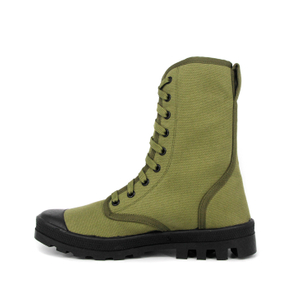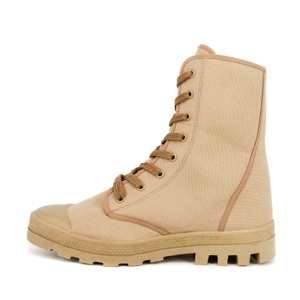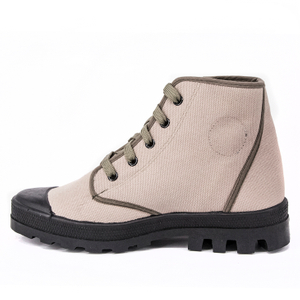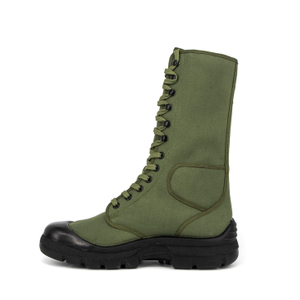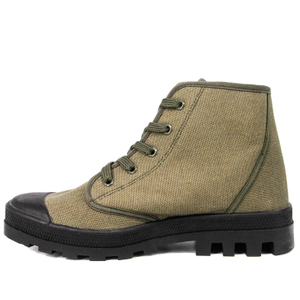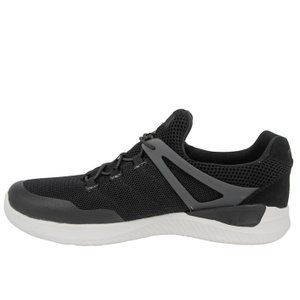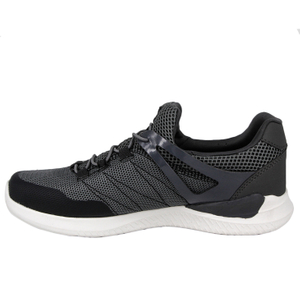You may ask why boot construction methods are important when picking boots. How boots are made changes how long they last. It also changes how comfortable they are. The way boots are built affects how much they are worth.
Construction Method | Durability | Comfort | Value |
Direct-attach construction | Moderate | High | Moderate |
Goodyear welt construction | High | Low | High |
Brands like Milforce use special boot construction methods to make their footwear. These methods help boots work well for jobs, the military, or outdoor trips.
Key Takeaways
The way boots are made changes how long they last, how comfy they feel, and how much they are worth. Pick the right kind for what you need.
Goodyear welt and Norwegian welt boots are very strong. You can fix their soles, so they last a long time.
Cemented and Blake stitch boots are light and feel good right away. But they might not last as long as other types.
If you need boots that keep water out, look at injection-molded or vulcanized boots. These types stop water from getting in.
Always pick boots that fit your life and where you will wear them. This helps you get the best comfort and use.
Boot Construction Methods Overview
Types of Boot Construction
Boots are not all made the same way. The way boots are built changes how they feel and last. Some ways make boots strong. Other ways make boots light or easy to bend. There are a few main types of boot construction in the shoe world.
Goodyear welt construction
Cement construction
Stitch-down construction
Injection-molded construction
Each type uses different materials and steps. Goodyear welt construction is known for being tough and keeping water out. You can get these boots resoled, so they last longer. Cement construction uses glue to stick the top to the sole. This makes boots lighter but not as strong. Stitch-down construction sews the top right to the sole, which helps stop water from getting in. Injection-molded construction melts materials to make the sole and attach it to the top, making boots strong and bendy.
Tip: If you want boots that last, pick Goodyear welt or stitch-down construction. If you want light boots, cement or injection-molded boots are good choices.
Shoe Construction Methods
Shoe construction methods are a lot like boot construction. The main types are Goodyear welt, Blake stitch, cemented, vulcanized, Norwegian welt, stitchdown, and hand welted. Each way makes shoes feel and look different.
Goodyear welt uses a strip of leather or rubber to join the top, making shoes strong and easy to fix.
Blake stitch connects the top right to the sole, so the shoe is lighter.
Cemented construction uses glue, making shoes light but not as tough.
Vulcanized construction uses heat and chemicals to stick rubber, making shoes strong and bendy.
Norwegian welt and stitchdown add extra stitches for more strength and to keep water out.
Hand welted shoes are made with great skill and last a long time.
You can find other shoe construction types, like Norwegian welt and hand welted, in fancy or special shoes. These types focus on being strong and looking nice. Picking good shoe construction gives you more comfort and longer-lasting shoes.
Goodyear Welt Construction
How Goodyear Welt Construction Works
You may wonder how goodyear welt construction makes boots strong and long-lasting. This method uses a strip called a welt, which connects the upper part of the boot to the sole. The welt runs around the edge of the boot, and workers stitch it to both the upper and the sole. You get a tight seal that helps keep water out. Many boots use storm welt construction, which adds an extra layer to block water and dirt. You see this in boots made for tough jobs or wet places.
Goodyear welt construction started in the late 19th century. Charles Goodyear Jr. improved a machine first designed by August Destouy in 1862. This new way of making boots changed the industry. You get boots that last longer and can be fixed easily. Storm welt construction builds on this idea by adding more protection.
When you pick boots with goodyear welt, you choose a style that gives you support and stability. You also get the option to resole your boots when the soles wear out. Many people like storm welt construction for outdoor boots because it keeps feet dry.
Note: Goodyear welt construction and storm welt construction both help boots last longer and stay strong in rough conditions.
Pros and Cons
Here is a table that shows the main advantages and disadvantages of goodyear welt construction compared to other methods:
Advantages | Disadvantages |
Durability | Higher cost |
Resoleability | Stiffness and longer break-in period |
Water resistance | Heavier weight |
Enhanced stability and support | Limited water resistance compared to some methods |
| Reduced insulation in cold conditions |
You get boots that last and can be repaired. Goodyear welt construction gives you water resistance and support. Storm welt construction adds even more protection. You may notice that these boots feel heavier and take longer to break in. Some boots with goodyear welt do not keep your feet as warm in cold weather. You pay more for these boots, but you get value and strength.
Blake Stitch Construction
How Blake Stitch Works
Blake stitch construction uses one row of stitching. This row connects the upper part to the insole and outsole. The layers are close together. The boot feels slim and bends easily. Many blake stitched boots use this method. It saves time and materials. Italian boots often use blake rapid construction. These boots are light and easy to bend.
Blake rapid has a stitch inside the boot. It holds all the parts tightly. The boot does not feel bulky. You can wear these boots for many hours. They do not feel heavy. The single stitch lets the boot bend with your foot. This gives you more comfort. Sacchetto construction and moccasin construction are similar. They also make boots soft and flexible.
Tip: Pick blake stitch construction if you want boots that move with your feet.
Pros and Cons
Blake rapid construction has good points and some bad ones. You should know these before you buy boots.
Pros:
The boots are light and easy to walk in.
The sole bends with your foot.
The slim look is stylish.
Making these boots is fast and cheap.
Many blake stitched boots are comfy for daily use.
Cons:
These boots do not keep water out well.
It is harder to resole than Goodyear welt boots.
The stitching can wear out faster if used roughly.
Sacchetto construction and moccasin construction also focus on comfort and bending. Blake rapid is special because it is built quickly and works well. If you want boots that feel light and bend easily, blake stitch construction is a good choice.
Feature | Blake Stitch Construction | Goodyear Welt Construction |
Flexibility | High | Moderate |
Weight | Light | Heavy |
Water Resistance | Low | High |
Repairability | Moderate | High |
Cemented Construction
How Cemented Construction Works
You may notice that many modern boots use cement construction. This method glues the upper part of the boot directly to the sole. Workers use a strong adhesive to bond these parts together. You do not see any stitches on the outside. The glue creates a tight seal that holds the boot together.
Cement construction is a flexible construction method. It lets manufacturers make boots quickly. You get a lightweight boot that feels comfortable right away. Many athletic shoes and casual boots use cement construction because it saves time and cost. You can wear these boots straight out of the box. They do not need a long break-in period.
Tip: If you want a boot that feels soft and bends with your foot, cement construction is a good choice.
Pros and Cons
Cement construction has both strengths and weaknesses. You should know these before you choose your next pair of boots.
Pros:
You get lightweight boots that are easy to wear.
Cement construction makes boots more affordable.
The boots feel flexible and comfortable from day one.
You do not need to wait for the boots to break in.
The process works well for many styles, including work boots and casual shoes.
Cons:
Cement construction does not last as long as a rigid construction method like Goodyear welt.
You cannot resole most boots made with cement construction.
The glue may weaken if you use the boots in very wet or hot conditions.
Feature | Cement Construction | Goodyear Welt (Rigid Construction Method) |
Weight | Light | Heavy |
Flexibility | High | Moderate |
Durability | Moderate | High |
Repairability | Low | High |
Break-in Time | Short | Long |
You can see that cement construction offers comfort and flexibility. If you want a boot for daily use or light work, this method works well. For heavy-duty needs, you may want a more rigid construction method.
Vulcanized Construction
How Vulcanized Construction Works
You often see vulcanized construction in rubber boots. This method uses heat and chemicals to stick rubber panels together. Workers put these panels around the boot lining. The process makes a shell that is strong and bends easily. These boots can handle hard jobs and bad weather.
Many jobs need boots made with vulcanized construction. You find these boots in farming, fishing, and building work. People pick them because they last for many seasons. The boots do not wear out fast, even in rough places. You do not have to worry about them breaking soon.
Tip: Vulcanized boots are good for wet, muddy, or tough places.
Rubber boots with vulcanized construction are very common.
These boots are great for outdoor work and hard jobs.
You see them in farming, fishing, and building work.
Vulcanized boots last for many seasons.
Pros and Cons
Vulcanized construction has many good points. These boots keep water out. The rubber panels are stuck together, so the boots are waterproof. This helps you stay dry in rain or puddles. The boots also do not get damaged easily.
Here is a table that shows the main pros and cons of vulcanized construction:
Pros | Cons |
Excellent water resistance | Less breathability |
High durability | Heavier than some styles |
Flexible and strong | Limited style options |
Good for harsh environments | Not easy to repair |
You may see that vulcanized boots are heavier than other boots. They do not let air in, so your feet might get hot. There are not many styles to pick from. It is hard to fix these boots because the rubber is fused. Still, these boots protect your feet and last a long time.
Vulcanized construction keeps your feet dry and safe. You can trust these boots for hard jobs and wet places.
Injection Molded Construction
How Injection Molded Construction Works
You may wonder how injection-molded construction shapes boots. This method uses a machine to push melted rubber or thermoplastic into a mold. The mold makes the sole and connects it to the top part. The process is fast and makes a strong bond. There are no stitches or glue holding the sole. The sole and upper become one solid piece. These boots are tough and waterproof. You often see this method in work boots and outdoor boots. It works well for wet or messy places. The process can add special features, like strong toe caps or slip-resistant soles.
Tip: If you need boots for hard jobs or wet places, injection-molded construction gives extra protection and lasts longer.
Pros and Cons
Injection-molded construction has many good points for people who need strong boots. These boots stand up to rough use and keep feet dry. The table below shows the main features and benefits:
Feature | Description |
Waterproof | Makes a waterproof barrier to keep feet dry. |
Durability | Stands up to scrapes, tears, and holes in tough places. |
Chemical Resistance | Handles chemicals, oils, acids, and alkalis well. |
Slip-Resistant | Tread patterns help stop slips on wet floors. |
Comfortable Fit | Gives comfort and room for toes all day. |
Reinforced Toe and Heel | Strong toe caps and heels protect and help boots last. |
Easy to Clean | Simple to clean after use in dirty places. |
Choosing injection-molded boots can help the environment. Many factories use green materials and try to make less waste. The table below shows how this method helps the planet:
Key Technological Advancements | Description |
Sustainable Practices | Green materials and less waste make the process better for the earth. |
Some people think injection-molded boots do not have many style choices. These boots may not let air in as well as leather boots. Still, you get boots that last, protect your feet, and are easy to clean.
Note: Injection-molded construction is best for boots that need to handle water, chemicals, and tough jobs.
Norwegian Welt Construction
How Norwegian Welt Works
Some people call this norvegese construction. Norvegese is a special way to make boots strong and waterproof. You see norvegese in boots for hard work and wet places. Norvegese construction uses two rows of stitching. One row joins the upper to the midsole. The other row connects the midsole to the outsole. This double stitching makes norvegese boots very tough.
Norvegese construction uses a wide welt. The welt goes around the boot and helps keep water out. Norvegese boots often have a raised edge. This edge gives more protection from mud and water. These boots can handle snow, rain, and rough ground. Norvegese is popular in places with bad weather.
Many brands use norvegese construction for their best boots. Yuketen makes Italian norvegese boots that are very waterproof. Heschung uses norvegese for ski boots to keep feet dry in snow. Paraboot, a French brand, also uses norvegese to make strong, waterproof shoes.
Norvegese construction is known for its double stitching and wide welt. These boots last a long time and keep your feet dry.
Pros and Cons
You might wonder why norvegese is special. Norvegese construction gives you some big benefits:
Norvegese boots are very tough and keep water out. You can wear them in rain, snow, or mud.
Norvegese construction is great for hiking, working, or skiing in wet places.
The double stitching in norvegese keeps the sole tight and strong.
You may want to see how norvegese compares to other methods. Here is a table to help you:
Feature | Norvegese Construction | Goodyear Welt Construction |
Durability | Maximum | High |
Water Resistance | Superior | Moderate |
Comfort | Moderate | High |
Best Use | Rugged, wet places | Everyday, versatile |
Some people say norvegese boots feel stiff at first. You may need time to break them in. Norvegese construction can also make boots heavier. Still, if you want boots that last and keep water out, norvegese is a great choice.
Tip: Pick norvegese construction if you need boots for bad weather or hard jobs. You get strong boots and good water protection that lasts.
Stitchdown Construction
How Stitchdown Works
You may notice that stitch-down construction looks different from other boot methods. In stitchdown construction, you see the upper leather flared out and stitched directly to the midsole or outsole. Workers fold the leather outward, then sew it flat along the edge of the sole. This creates a wide, visible stitch line around the boot. You get a strong bond between the upper and the sole.
Stitchdown construction lets the upper material shape itself around your foot. This method creates extra air space inside the boot. Your foot rests evenly on the sole, which helps you feel more comfortable. The design avoids the tightness that happens when leather wraps under the foot. Many boots with stitch-down construction include a free-hanging bootie inside. This bootie gives you extra cushioning and adapts to your foot for a better fit.
You often see stitch-down construction in boots made for outdoor use. The process makes boots flexible and easy to wear. You can walk, bend, and move without feeling stiff. Stitchdown construction also helps keep water out, especially when paired with a wide stitch and good materials.
Tip: If you want boots that feel flexible and comfortable, stitchdown construction is a smart choice.
Pros and Cons
Stitch-down construction gives you many benefits, but you should know both sides before you choose.
Pros:
You get excellent flexibility and comfort.
The boots adapt to your foot shape over time.
Stitchdown construction allows for easy repairs.
The wide stitch helps keep water out.
Many outdoor and desert boots use stitch-down construction for these reasons.
Cons:
Stitch-down construction may not be as waterproof as some other methods.
The exposed stitching can wear down if you use the boots in rough places.
You may need to resole the boots more often if you use them hard.
Here is a table showing popular boots that use stitchdown construction:
Boot Type | Construction Type |
Clarks Desert Boot | Stitchdown |
Veldtschoen Boots | Similar to Stitchdown |
You can see that stitch-down construction is common in boots made for dry, rugged places. The method gives you a balance of comfort, flexibility, and repair options. If you want boots that move with you and feel good all day, stitchdown construction is worth considering.
Hand Welted Construction
How Hand Welted Works
Hand welted construction stands out as one of the oldest and most respected ways to make boots. You see this method in high-end and custom boots. Skilled workers use their hands to attach a strip of leather, called a welt, to the upper and insole. They sew the welt to the upper, then stitch the outsole to the welt. This process creates a strong and flexible bond.
You get boots that fit your feet well because the maker can shape the leather during the process. Hand welted boots often use thicker leather and more layers. This gives you extra support and comfort. The process takes time and skill. Each pair of boots can take many hours to finish. Makers check every step to make sure the boots meet high standards.
Tip: If you want boots that last for years and can be resoled many times, hand welted construction is a top choice.
Pros and Cons
Hand welted boots offer many benefits, but you should know both sides before you decide.
Pros:
You get excellent durability. Hand welted boots can last for decades with care.
The boots can be resoled many times, so you save money in the long run.
You enjoy a custom fit. The leather shapes to your foot over time.
The construction gives you good water resistance.
Cons:
Hand welted boots cost more because they take longer to make.
You may wait longer for your boots since the process is slow.
The boots can feel stiff at first and need a break-in period.
Here is a table that shows how hand welted construction compares to machine methods:
Construction Method | Labor Intensity | Time Requirements |
Hand Welted | High | Longer |
Machine Methods | Lower | Shorter |
Note: Hand welted boots require more skill and time, but you get unmatched quality and longevity. If you value craftsmanship and want boots that can handle tough use, this method is worth considering.
Work Boot Construction
Best Construction Methods for Work Boots
When you want strong boots, you should know which methods work best. Work boot construction needs to be tough and safe. There are a few main ways to build work boots. Each way has its own good and bad points.
Here is a table that shows the main boot construction methods for work boots:
Construction Method | Pros | Cons |
Goodyear Welt Construction | Excellent durability, easy resoling | Heavier weight, limited water resistance, reduced insulation |
Cement Construction | Lightweight, flexible, quick break-in | Less durable, difficult resoling, higher risk of water penetration |
Stitch-down Construction | Enhanced stability, easy repair, good shock absorption | Limited waterproofing, higher resoling costs, less flexibility |
Injection-Molded Construction | Excellent waterproofing, chemical resistance, enhanced protection | N/A |
Goodyear welt construction makes boots last a long time. Stitch-down construction helps boots stay steady and absorb shocks. Cement construction makes boots light and easy to wear. Injection-molded construction keeps feet dry and safe from chemicals. When you pick work boots, think about your job and where you work.
Tip: If you work in wet or dirty places, injection-molded boots keep your feet safe. For hard jobs, Goodyear welt and stitch-down boots give extra strength.
Durability and Safety Considerations
You want work boots that protect you and last a long time. The way boots are built changes how safe they are. Stitch-down construction gives more stability, so you slip less. Injection-molded boots have no seams, so water stays out. Cement construction lets boots bend with your feet, so you feel less tired.
Pick work boots that fit your needs. If you do heavy work, choose boots with strong soles and good support. If you work near water or chemicals, injection-molded boots keep your feet safe. The right boot construction gives you comfort and safety every day.
Remember: Good work boot construction helps you stay safe, comfortable, and ready for any job.
Comparing Boot Construction Methods
Durability and Longevity
You want boots that last a long time. The way boots are built changes how strong they are. Goodyear welt boots are some of the toughest. You can wear them for years, even for hard work. Hand welted and Norwegian welt boots also last because they use thick materials and double stitching. Injection-molded and vulcanized boots do not get ruined by water or chemicals. These boots work well in rough places.
Cemented boots do not last as long. The glue can break down, especially in wet or hot places. Blake stitch boots are light and bendy, but they wear out faster than Goodyear welt boots. If you want boots that last, pick Goodyear welt, Norwegian welt, or hand welted construction.
Boots made with care and strong methods give you the best value over time.
Comfort and Flexibility
It is important for boots to feel good all day. Some boots feel stiff when new. Goodyear welt boots take time to get soft. You need to wear them for a while before they feel right. Hand welted boots also need time to fit your feet.
Other boots feel comfy right away. Blake stitch boots bend easily and do not need much break-in. Cemented boots are soft and flexible from the start. Injection-molded boots give you space and support. Stitchdown boots shape to your feet and feel flexible.
Goodyear welt: Strong and keeps out water, but stiff and takes longer to break in.
Blake stitch: Bends easily and feels comfy, but does not last as long or keep out water as well.
Cemented construction: Cheap and comfy with some water resistance, but does not last long and cannot be resoled.
If you want boots that move with your feet, choose Blake stitch, cemented, or stitchdown construction.
Water Resistance
Water can ruin boots if it gets inside. Some ways of making boots keep water out better. Goodyear welt and Norwegian welt boots use special stitching and welts to block water. Hand welted boots also keep water out. Vulcanized and injection-molded boots use rubber and sealed seams, so they are great for wet places.
Lab tests like SATRA TM 230:2014 and SATRA TM 446:2015 show vulcanized and injection-molded boots keep water out best. These tests bend the boots in water and check for leaks. If you need boots for rain, snow, or mud, pick vulcanized, injection-molded, or Norwegian welt construction.
Tip: For the best water protection, pick boots made with vulcanized or injection-molded construction.
Repair and Resoling
Sometimes you want to fix your boots instead of buying new ones. Some boots are easy to repair and resole. Goodyear welt boots can be resoled many times. You pay more at first, but you save money later. In the U.S., resoling costs from $75 to $200, but Goodyear welted boots are worth it because they last.
Blake stitch boots can be resoled, but it is harder and needs special machines. Cemented boots cannot be resoled. The glue does not hold up, so you need to buy new boots when they wear out. Hand welted and Norwegian welt boots are also easy to fix and resole.
If you want boots you can fix and keep for years, pick Goodyear welt, hand welted, or Norwegian welt construction.
Price and Value
Boot prices change based on how they are made. Goodyear welt, hand welted, and Norwegian welt boots cost more. You pay for the skill and time it takes to make them. These boots last longer and can be fixed, so they give you better value over time.
Cemented and Blake stitch boots cost less. They are good if you want to save money now, but you may need to buy new ones sooner. Injection-molded and vulcanized boots have prices that can be low or high. They are a good deal if you need strong, water-resistant boots for work or outside.
Construction Method | Durability | Comfort | Water Resistance | Repairability | Price Range |
Goodyear Welt | High | Moderate | High | High | $$$ |
Blake Stitch | Moderate | High | Moderate | Moderate | $$ |
Cemented | Moderate | High | Moderate | Low | $ |
Vulcanized | High | Moderate | Very High | Low | $$-$$$ |
Injection Molded | High | High | Very High | Low | $$-$$$ |
Norwegian Welt | Very High | Moderate | Very High | High | $$$ |
Stitchdown | High | High | Moderate | High | $$-$$$ |
Hand Welted | Very High | Moderate | High | High | $$$$ |
How Milforce Uses Different Construction Methods
Milforce uses different ways to make boots for different needs. For example:
Military and combat boots often use Goodyear welt or injection-molded construction for strength and water resistance.
Tactical boots use cemented or stitchdown construction for light weight and comfort.
Desert boots use stitchdown construction for air flow and easy movement.
Jungle boots use vulcanized construction for the best water resistance and grip.
You can pick the right Milforce boot for your job or activity. Each way of making boots gives you special benefits for different places.
Choosing the Right Boot Construction
Matching Construction to Needs
You want boots that fit your life and your work. The way boots are made changes how they perform in different situations. Start by thinking about where you will wear your boots and what you will do in them.
If you work outside in wet places, you need boots that keep water out. Goodyear welt, Norwegian welt, injection-molded, and vulcanized boots give you strong water protection. For dry and hot places, you want boots that let your feet breathe. Cemented and stitchdown boots often use lighter materials and let air flow.
You should also think about how long you want your boots to last. Goodyear welt, hand welted, and Norwegian welt boots last many years and can be fixed when they wear out. Cemented boots feel soft and light but do not last as long.
Here is a table to help you match boot features to your needs:
Factor | Description |
Waterproofing | Keeps feet dry in rain, snow, or mud. Look for sealed seams and water-resistant materials. |
Breathability | Helps feet stay cool in hot or humid places. Air-mesh panels and moisture-wicking liners help. |
Boot Height | Higher boots protect ankles and give more support on rough ground. |
Ankle Support | Prevents injuries on uneven trails. Reinforced designs work best. |
Weight | Lighter boots help you move fast and feel less tired. |
Comfort | Soft linings and cushioned soles make boots comfortable all day. |
Terrain-Specific Features | Rugged outsoles, strong grip, and toe protection help in forests, mountains, or deserts. |
Tip: Always check if the boots have the right features for your job or adventure.
Lifestyle and Use Cases
Your daily life shapes the boots you need. If you spend hours on your feet at work, comfort matters most. Choose boots with cushioned insoles and flexible soles. If you hike or work in forests and mountains, you need rugged outsoles, strong ankle support, and waterproof materials. These features keep you safe and dry on rough trails.
For desert or hot climates, pick boots with breathable fabrics and moisture-wicking liners. These keep your feet cool and dry. If you work in cold weather, insulated boots protect your feet from the cold.
Here is a quick guide for different environments:
You should also think about how often you will wear your boots. If you need boots every day, choose a style that feels good and lasts long. If you only wear boots for special trips, you can pick lighter or more stylish options.
Note: The right boot construction keeps your feet safe and comfortable, no matter where you go.
Style Preferences
Boots come in many styles. The way they are made changes how they look and feel. Some people like classic boots with thick leather and strong stitching. Goodyear welt and hand welted boots give you a traditional look and last for years. These boots often have a sturdy shape and can be polished to look new.
If you want a slim and modern style, Blake stitch boots work well. They look sleek and feel light. Cemented boots come in many colors and shapes. You can find sporty, casual, or dressy styles.
Think about what matches your clothes and your taste. Do you want boots that stand out or blend in? Do you like boots that look tough or boots that look simple? Your style helps you pick the right construction.
Construction Method | Best For Style | Typical Look |
Goodyear Welt | Classic, rugged, timeless | Thick, sturdy |
Blake Stitch | Sleek, modern, dressy | Slim, flexible |
Cemented | Sporty, casual, versatile | Lightweight, varied |
Hand Welted | Luxury, custom, heritage | Rich, detailed |
Stitchdown | Outdoor, vintage, practical | Wide-stitched, robust |
Remember: Your boots should fit your needs, your life, and your style. Take time to choose the construction that matches you best.
Conclusion
Understanding boot construction methods helps you make smart choices. Each method offers different strengths and weaknesses. You should think about your needs, where you will wear your boots, and your budget before you buy.
If you feel unsure, talk to an expert or check out trusted brands like Milforce. They can help you find the right boots for your job or adventure.
FAQ
What is the most durable boot construction method?
Goodyear welt, Norwegian welt, and hand welted boots give you the most durability. These methods use strong stitching and thick materials. You can wear these boots for years, even in tough conditions.
Can you resole all types of boots?
You can resole Goodyear welt, hand welted, Norwegian welt, and stitchdown boots. Cemented and injection-molded boots usually cannot be resoled. Always check with your boot maker for repair options.
Which construction is best for waterproof boots?
For the best waterproof boots, choose injection-molded or vulcanized construction. These methods seal out water and keep your feet dry in wet conditions.
Are lighter boots less durable?
Lighter boots often use cemented or Blake stitch construction. These boots feel comfortable and flexible. They may not last as long as heavier boots with Goodyear welt or Norwegian welt construction.
How do I choose the right boot construction for my needs?
Make a list of your needs. Think about where you will wear your boots, how much comfort you want, and your budget. Use the comparison table above to match features to your lifestyle.












